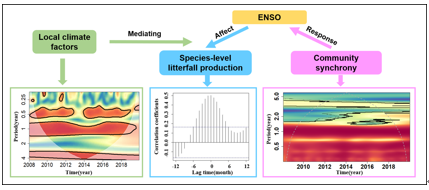New Study Uncovers the Regulatory Effects of El Ni#n;o–Southern Oscillation (ENSO) on Temperate Forests’ Seed and Leaf Fall
Seed and leaf fall, regulating community assembly and nutrient cycling, are critical components in forests ecosystems. Understanding the interannual variation in seed and leaf fall is key to predicting dynamics of terrestrial ecosystems in response to climate change. ENSO is considered as a powerful predictor for seed and leaf fall, which have been demonstrated in tropical forests but rarely been concerned in temperate forests. ENSO is one of the most prominent large-scale climate patterns, which is defined as a fluctuation between warm (El Ni#n;o) and cold (La Ni#n;a) conditions in the tropical Pacific, and tending to present in 2-7 years. Variation of sea temperature and intensity of rainfall related to ENSO lead to widespread changes in atmosphere circulation outside the tropical Pacific and affecting ecosystems worldwide. Under the context of increasing frequency and intensity of ENSO events induced by global warming, it is necessary to explore the ENSO effects on forests ecosystems.
To reveal how ENSO affects the temporal variation of species-level seed and leaf fall, researchers from Institute of Applied Ecology Chinese Academy of Sciences estimated the relationships among ENSO, local climate, and litterfall, using a 12-year data set of seed and leaf fall in a temperate forest of northeast China, with corresponding local climatic data (relative humidity and precipitation) and two ENSO indices (ENSO12 and ENSO34).
The results showed that the effects of ENSO on seed and leaf fall were all significant, but varied with species (r=0.206-0.658). Acer pseudo-sieboldianum had the most strongly response to ENSO among the seven studied species, whose seed and leaf was explained 40% and 34% by ENSO indices, respectively.
Interestingly, this study found the community synchrony of leaf fall in response to ENSO cycles for the first time; differently, seed fall was only showed synchrony patterns at seasonal scales, but the signals of synchrony were stronger when ENSO occurred than in normal years. Local climate factors mediating the ENSO effects on the litterfall production, that is rainfall and relative humidity significantly correlated with seed fall of Fraxinus mandshurica and Tilla amurensis at ENSO scales, respectively.
This study systematically elucidates the effects of ENSO on temperate forests’ seed and leaf fall and provided new evidence that ENSO affects terrestrial ecosystems worldwide by atmospheric teleconnections.
This study was published in Science of the Total Environment entitled “El Ni#n;o–Southern Oscillation affects the species-level temporal variation in seed and leaf fall in a mixed temperate forest”. Meihui Zhu (from Institute of Applied Ecology, Chinese Academy of Sciences) and Zhanqing Hao (from School of Ecology and Environment, Northwestern Polytechnical University) are the first author and corresponding author, respectively. This study was supported by the National Natural Science Foundation of China and the Strategic Priority Research Program of the Chinese Academy of Sciences.

Fig.1. Graphical abstract (Image by ZHU Meihui).



